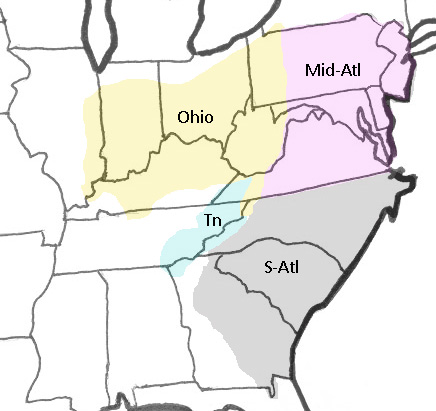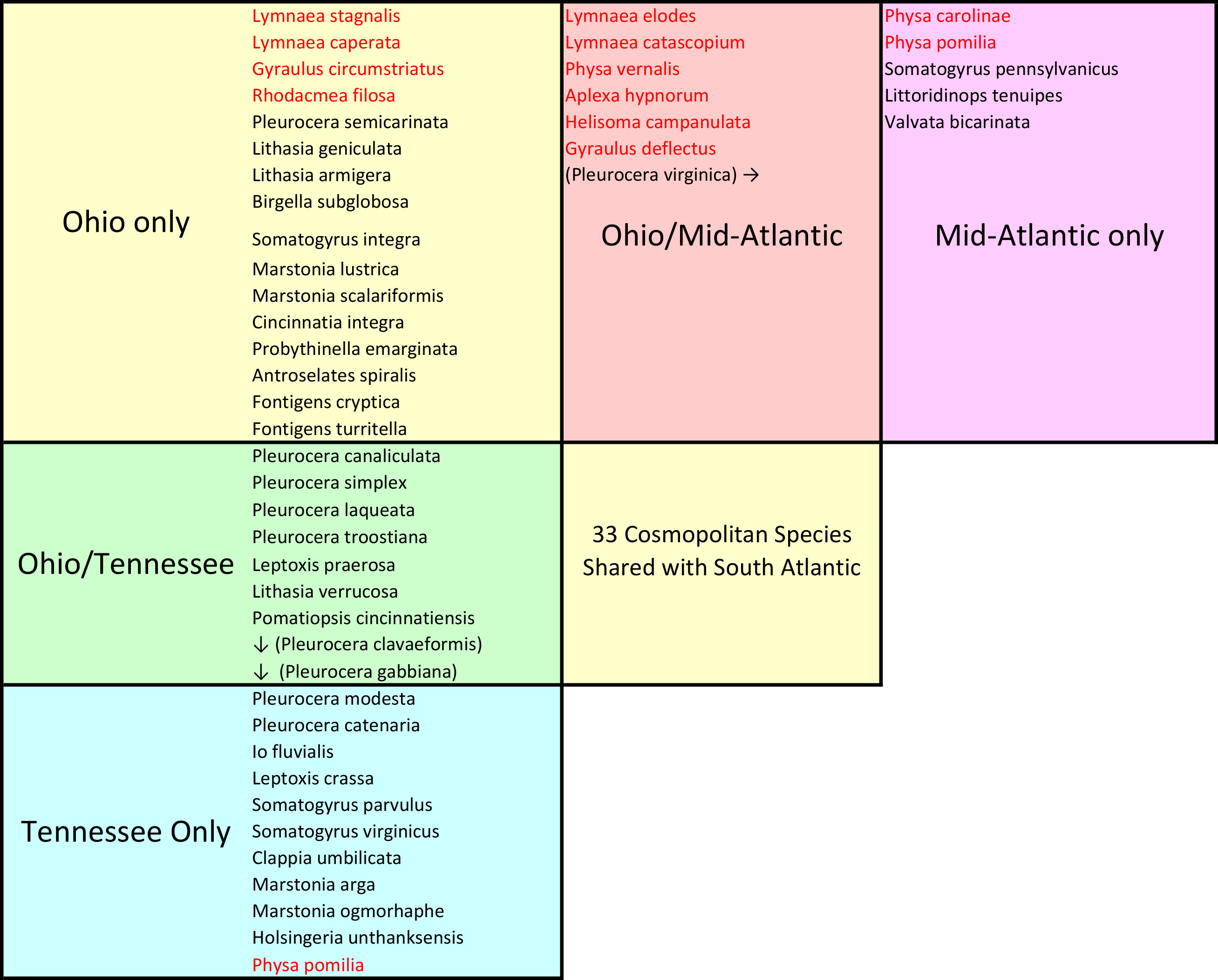
The 70 gastropod species and subspecies we have recovered from the
waters of the Ohio River above the mouth of the Tennessee/Cumberland
are tabulated by state in Table 2. Table 2 is available at right
either as a pdf file or as an excel spreadsheet, which may be selected
by column and sorted by any particular state of interest.
Combining subspecies, the 64 species are ordered by their number
of incidences in our
5,250-record database in Table 3, giving common synonyms and overall
(15-state) FWGNA incidence ranks.
Dillon and
colleagues (2019a) also reported 70 species and subspecies of freshwater
gastropods inhabiting Atlantic drainages from Georgia to the New York
line. This fauna is dividable into a set of cosmopolitan species,
a set of endemics or near-endemics, and a set of species demonstrating
north-south regionalism. A comprehensive “FWGTN” gastropod survey
is available from the waters of East Tennessee (Dillon & Kohl
2013). The list of 40 species and subspecies recovered by Dillon
& Kohl also included cosmopolitan and endemic elements, as well as
a set of species which, when compared to the Atlantic drainage fauna,
demonstrated an east-west regionalism.

With the addition of
survey results from the Ohio drainages, we can now examine the
distribution of the North American gastropod fauna for evidence of both
north-south and east-west regionalism simultaneously. And let us
combine subspecies for a continental-scale analysis, bringing the lists
down to 64 species for The Ohio, 69 for the Atlantic drainages, and 39
for Tennessee.
Next let us subdivide the 69-species Atlantic
drainage fauna into South-Atlantic and Mid-Atlantic halves at north
latitude 36.54°, the North Carolina / Virginia line. We find that
18 species are unique to the South-Atlantic and 12 unique to the
Mid-Atlantic, with an overlap of 39 species. The 18 uniquely
South-Atlantic species will be set aside for the present analysis.
Then
of the 69 – 18 = 51 Atlantic species remaining, 33 are shared with the
drainages of The Ohio. Let us call these 33 species
“cosmopolitan” at the scale of the present analysis: extending (at
minimum) from the Carolinas both north and west across the eastern
continental divide. Then 64 – 33 = 31 Ohio drainage species
demonstrate some degree of regionalism. These 31 species are
classified in Figure 2.
Figure
2 below lists 16 species as occurring in Ohio drainages only.
These are 4 pulmonates (in red font) and 12 prosobranchs
(in black) that have not been previously recorded by FWGNA surveys of
any other region – 9
hydrobioids, 3 pleurocerids, 2 lymnaeids, 1 planorbid and 1
ancylid. We should hasten to stipulate that we have not published
any results from the Great Lakes drainages to the north nor Mississippi
drainages to the west, so these 16 species are not necessarily endemic
to drainages of The Ohio. They are not, in any case, shared with
drainages of the Atlantic or East Tennessee.
A set of 6 Ohio species, all pulmonates, are shared with Mid-Atlantic states, but not with other regions (pushing the single NW Pennsylvania population of Pleurocera virginica aside as accidental). And compared with drainages of The Ohio, the Mid-Atlantic states have six unique species, 2 pulmonates and 4 prosobranchs. This is a clear demonstration of East/West regionalism in the freshwater gastropods of North America. The phenomenon might best be characterized as a gradual turnover of pulmonates proceeding east, slightly net negative, and an abrupt discontinuity of prosobranchs, strikingly net negative.
Figure 2 above also shows that the Ohio fauna shares a set of 7 species, almost all
pleurocerids, with Tennessee drainages to the south (pushing down the
New/Kanawha populations of Pleurocera clavaeformis and P. gabbiana as
accidental). And the Tennessee list includes 13 species (6
pleurocerids, 6 hydrobioids, 1 pulmonate) not found in Ohio
drainages. This is a clear demonstration of North/South
regionalism in the freshwater gastropods of North America. The
phenomenon might best be characterized as a gradual turnover in
prosobranchs heading south, net neutral, and an abrupt discontinuity of
pulmonates, strikingly net negative.
Narrowing our focus to
biogeographic patterns within the Ohio River basin, we notice that the
distributions of many freshwater gastropods seem to reflect ecoregional
distinctions. The northern Glaciated Central Lowlands host quite
a few species not found elsewhere in the basin, including Marstonia
lustrica, Lymnaea stagnalis, Physa vernalis, Aplexa elongata, Helisoma
campanulata, Gyraulus deflectus, and G. circumstriatus.
Proceeding into the southern Glaciated Central Lowlands, we add
Viviparus georgianus, Probythinella emarginata, Cincinnatia integra,
and Lymnaea elodes. Pleurocera troostiana is restricted to the
Unglaciated Interior Low Plateau. Pleurocera simplex and P.
laqueata range through the Unglaciated Interior Low Plateau, extending
into the Appalachian Plateau.
We were surprised to discover
populations indistinguishable from Pleurocera simplex and P. troostiana
of East Tennessee as far north as Kentucky.
Goodrich
(1940) gave the range of Pleurocera (“Goniobasis”) simplex as
“headwaters of Tennessee River system in Virginia, Tennessee and North
Carolina; Beaver Fork of Bluestone River of Kanawha River, Mercer
County, West Virginia." He seems to have identified Kentucky and
Middle Tennessee populations as “Goniobasis ebenum,” which he
considered to range through “Cumberland River above the Falls; Smith’s
Shoals, Pulaski County, KY; springs and small streams of this river
(The Cumberland) downstream to Dickson County, TN.” And indeed,
Branson (1987) and Branson, Batch & Call (1987) listed Goniobasis
ebenum prominently in the Kentucky malacofauna, neglecting simplex
entirely.
Our observations suggest that populations bearing
shells of the simplex morphology intergrade smoothly with those bearing
shells of the ebenum morphology as stream size increases. We here
consider ebenum (Lea 1841) a subspecies of simplex (Say 1825) and
suggest that P. simplex (now more broadly understood) extends through
tributaries of the Kentucky and Green Rivers almost as far north as The
Ohio River, as well as throughout the Cumberland drainage.
Our
understanding of Pleurocera troostiana has also improved significantly
in recent years. Goodrich (1940) considered “Goniobasis
troostiana (Lea 1839)” endemic to its East Tennessee type locality,
Moss Creek in Jefferson County. But our surveys of East Tennessee
(Dillon & Kohl 2013) revealed that many more broadly-distributed
species were junior synonyms of troostiana, the distinctions
resting on phenotypically-plastic elements of the shell.
In
the present survey, we report pleurocerid populations indistinguishable
from troostiana through central and western Kentucky as far north as
the Ohio River. In this region they have historically been
identified as Goniobasis (or Elimia) plicata-striata, G. curryana, and
G. curryana lyoni (Bickel 1968, Branson 1987). We suggest that
all of these specific nomina: plicata-striata (Wetherby 1876), curryana
(Lea 1841), and lyoni (Lea 1863), are junior synonyms of troostiana
(Lea 1839).
> References
Bickel, D. (1968) Goniobasis curreyana lyoni, a pleurocerid snail of west-central Kentucky. The Nautilus 82: 13 - 18.
Branson, B.A. (1987) Keys to the aquatic Gastropoda known from Kentucky. Trans. Kentucky Acad. Sci. 48: 11 – 19.
Branson, B.A., D.L. Batch and S.M. Call (1987) Distribution
of aquatic snails (Mollusca: Gastropoda) in Kentucky with notes on
fingernail clams (Mollusca: Sphaeriidae: Corbiculidae) Trans.
Kentucky Acad. Sci. 48: 62 – 70.
Dillon, R.T., Jr., M.J. Ashton, W.K. Reeves, T.P. Smith, T.W. Stewart, & B.T. Watson (2019a) Atlantic
drainages, Georgia through Pennsylvania. Freshwater Gastropods of
North America, Volume 1. FWGNA Press. 199 pp.
Dillon, R. T., Jr. & M. Kohl (2013) The Freshwater Gastropods of Tennessee. Internet address: http://www.fwgna.org/FWGTN

